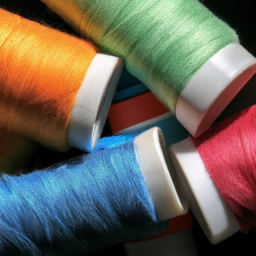

Sewing is an art form that involves various techniques and materials. When it comes to sewing, one of the most crucial elements is the thread selection. Choosing the right thread can make a significant difference in the quality and durability of your sewing project.
There are different types of threads available, each with its own unique characteristics. Polyester threads are commonly used due to their strength and resistance to stretching, making them suitable for many different fabrics. Cotton threads are popular for sewing lightweight and delicate fabrics like silk, as they offer excellent flexibility and avoid damage caused by tension.
Tip 1: When matching thread colors, it’s essential to pay attention to the fabric color and the thread being used. Choose a thread color that complements the fabric. If in doubt, go with a slightly darker shade as it will blend better than a lighter one.

Tip 2: Before starting a project, make sure to check the thickness and weight recommendations on both the sewing machine manual and the thread packaging. Using the wrong thread thickness might result in unbalanced stitching or even a broken needle.
While threads are essential, it’s also vital to consider the type of needle you use. Selecting the appropriate needle size based on the fabric and thread weight can ensure smooth sewing. Remember that different fabrics require different needle sizes, so always refer to the sewing machine manual for guidance.
“Using the right thread and needle combination not only improves the look of your sewn projects, but it also extends their lifespan.” – Angela Wright
Additionally, the thread tension on your sewing machine can greatly impact the quality of your stitches. To achieve optimal tension, you may need to make adjustments depending on the type of fabric and thread you’re using. Proper tension prevents loose stitches or puckering, resulting in a professional-looking finished product.
Tip 3: Be sure to clean your sewing machine regularly and remove any residual lint or tangled threads. Regular maintenance ensures the machine operates smoothly and prevents thread breakage during sewing.
In summary, sewing with the right threads is crucial for successful and durable projects. Ensure you select the appropriate thread type matching the fabric and understand the importance of needle sizes and machine tension. By following these tips, you’ll enjoy the art of sewing with beautiful, long-lasting results.





Such a helpful guide for beginners! #sewing #thread
Kelsey Ford: I’m excited to give this a try! #learningtoSew #thread
Fun and creative! Threading can be tricky but sewing with threads is such a great way to connect pieces of fabric and unleash your creativity. #sewing #thread
With threads, the possibilities really are endless! #sewing #thread
Absolutely love the projects you can make! #sewing #thread
Looking forward to creating something unique! #sewing #thread
A great stress-buster, plus a fun way to add decor to your space with homemade items! #sewing #thread